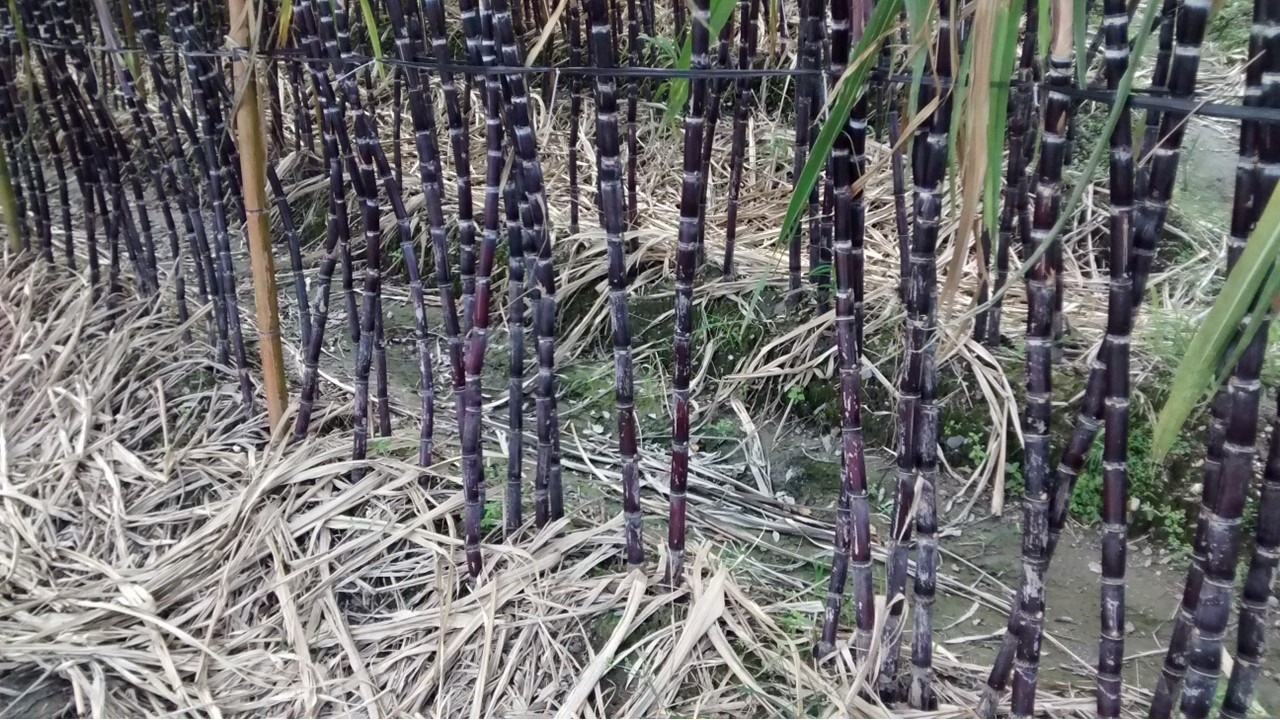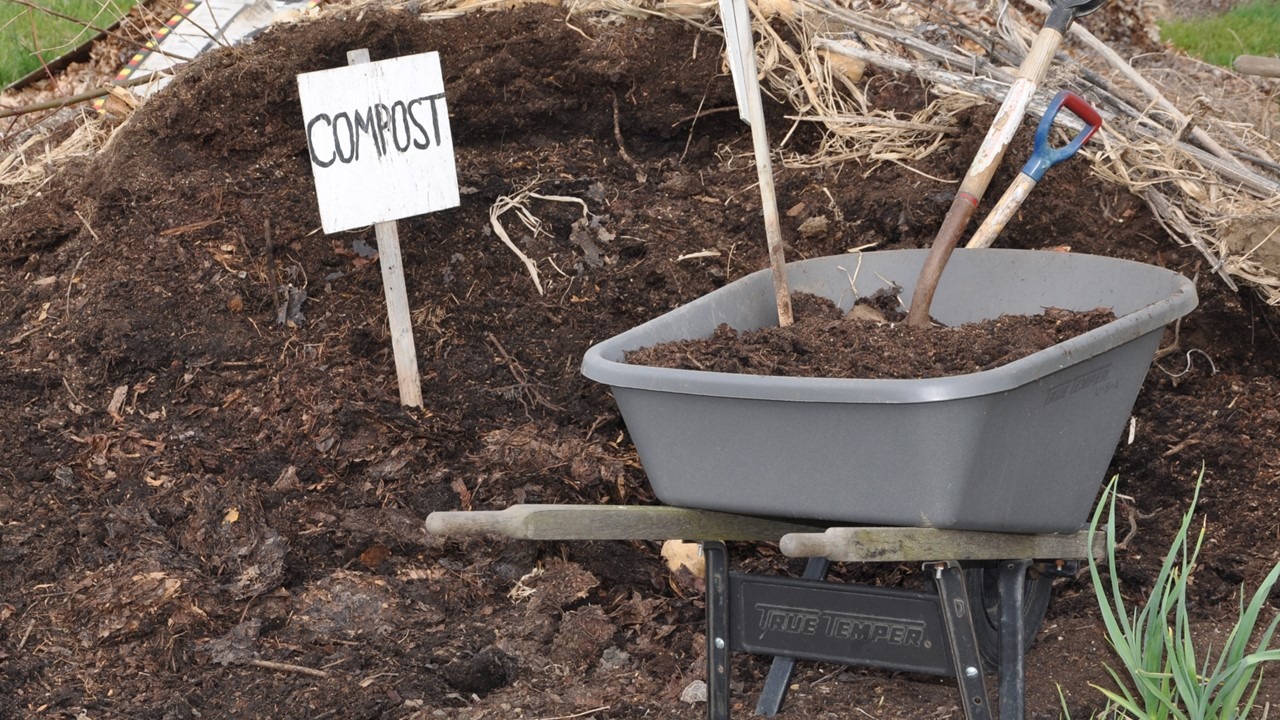“Biodegradable” and “compostable” are both adjectives for eco-friendly materials that replace plastic. In the age of plastic reduction, they often appear in national regulations, as part of the certificate names, or on product labels. They seem similar but are actually different. Being biodegradable doesn’t mean being compostable. In this article, we’ll explain the difference between “biodegradable” and “compostable” to help corporations and customers choose the actual eco-friendly products.
What does Degradable Mean?
According to the American Webster’s Dictionary, “degradable” is an adjective, meaning something that can be chemically degraded. It often appears alongside the word “biodegradable.”
Source: “degradable.” Merriam-Webster.com. Webster’s Dictionary, 2023. https://www.merriam-webster.com/dictionary/degradable. May 3, 2023.
Definition of Biodegradable
Being biodegradable means a material can be broken down by microorganisms in natural conditions (aerobic or anaerobic) with no time limit. Even plastic that takes hundreds of years to be decomposed is, broadly speaking, biodegradable. By the definition of “biodegradable” known and expected by the public, most natural materials are biodegradable, such as wood, leaves, paper, and food scraps.
Definition of Compostable
Compostable materials can be decomposed by microorganisms in a composting environment, becoming natural elements harmless to nature, including carbon dioxide, water, and nutrients. Meanwhile, as composting is a human activity, the conditions such as temperature, humidity, and decomposition time for compostable materials can be regulated. Many organizations have introduced internationally recognized certifications to assist countries in better managing and handling compostable products.
What’s the Differences Between Biodegradable and Compostable?
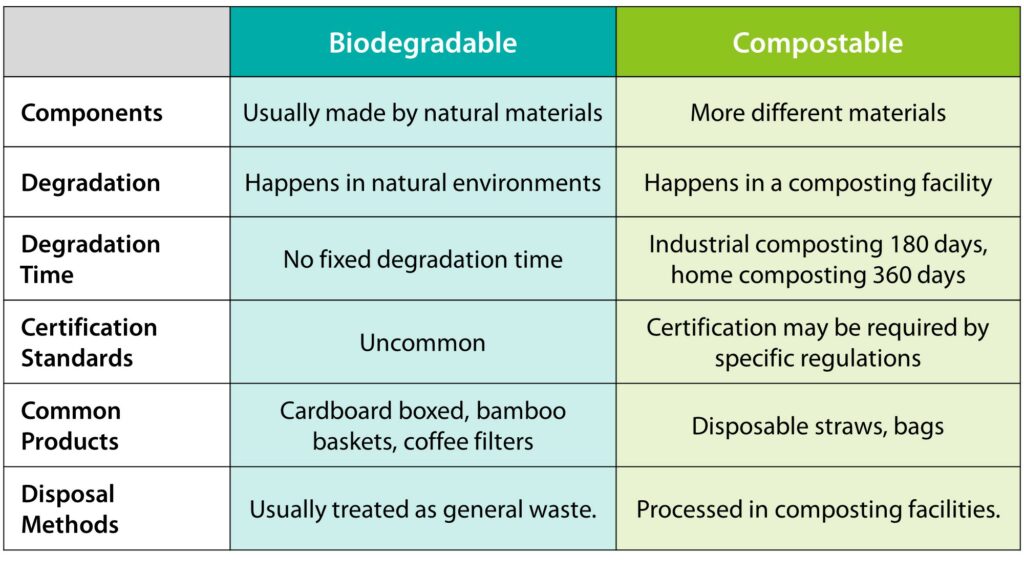
Components
Biodegradable products are usually made by processing natural materials, just as the items we instinctively think would decompose naturally, such as kraft paper bags, newspaper, and cardboard boxes made of paper pulp from wood as the raw material; tables, chairs, baskets, and straws made of bamboo; wine corks and bulletin boards made of cork; and clothes and hats woven from cotton or jute.
Besides natural materials, compostable products are often made of mixed or reconstructed organic or even non-organic materials, making it hard for consumers to see how these materials can be decomposed. Examples include poly lactic acid (PLA) synthesized from corn starch, cPLA and tPLA made from crystalized PLA or with added talc, JCPFM made of reshaped bagasse, PHA made through the fermentation of microorganisms, and polybutylene adipate terephthalate (PBAT) made from petrochemicals and widely used for plastic wrap and trash bags. These compostable products guarantee their compostability with certifications.
Degradation
The degradation of biodegradable materials happens in natural environments. The materials are first broken down by sunlight, wind, and rain. Meanwhile, microorganism colonies appear on the surface of biodegradable materials and produce a biofilm that contains enzymes which decompose organic compounds. They gradually degrade biodegradable materials into carbon, water, and minerals. In anaerobic environments, a different group of microorganisms is attracted which produces methane.
For a more detailed degradation process, please read this article:“What Does Biodegradable Mean, Definition of Biodegradable”
The degradation of compostable materials happens in a composting facility. An industrial composting facility first sorts the compost, mixes nitrogen-rich materials (like food scraps) with carbon-rich materials at a certain ratio, then makes a large composting pile and supplies it with ample oxygen, water, and microorganisms. The temperature of the composting pile rises to over 60°C, allowing the compost to decompose quickly.
Common home composting tools include compost bins and worm composting bin, which are smaller, ambient temperature composting tools. With regular turning and enough water, they can easily decompose products with home composting certifications.
For more information about home composting, please read this article: “The Benefits of Composting at Home and How to Compost at Home.”
Degradation time
Biodegradable materials have no fixed degradation time as it depends on various factors such as material structure, thickness, temperature, humidity, and the number of microorganisms in the natural environment. Generally, they take several months to years to decompose.
Compostable materials have time limitations based on regulations. The U.S. D6400, European EN 13432, and Australian AS 4736 standards apply to industrial composting and require 90% decomposition within 180 days. The European EN 13432 and NF T51-800 and the Australian AS 5810 standards apply to home composting and require 90% decomposition within 360 days. Most compostable products decompose a few weeks to several months faster than the time limit specified in the standards.
Certification standards
Currently, the only common biodegradable standard of certification with credibility is the OK biodegradable certification by TÜV AUSTRIA from Belgium. They are rarely included in legal regulations and consist of SOIL, WATER, and MARINE certifications, representing biodegradable materials that have been certified to decompose in soil, natural water with carbon such as rivers and lakes, and oceans, respectively. According to the document published by TÜV AUSTRIA, to obtain the most widely-used certification of TÜV AUSTRIA MARINE, a biodegradable material is required to decompose 90% or more within six months in seawater at about 30°C.
Common composting standards with credibility include OK compost HOME/INDUSTRIAL by TÜV AUSTRIA from Belgium, DIN-Geprüft industrially compostable by DIN CERTCO from Germany, COMMERCIAL COMPOSTABILITY CERTIFICATION from BPI in the U.S., and compostable and biodegradable plastics—“Biodegradable plastics suited for composting and other microbial treatment”/Home Compostable Verification by ABA from Australia. These certifications are issued based on the EN 13432, NF T51-800, and Australian AS 5810 standards mentioned above, confirming that a compostable material can decompose into harmless substances within the specified composting environment and time in the standards. Many countries require certain types of products to obtain these composting certifications before they can be legally sold in the domestic market.
Common products
All compostable products are biodegradable, most commonly disposable and thin material products. Common products include:
Straws: In most regions such as the EU, disposable plastic straws have been banned. Only compostable straws meet the local regulations. For example, renouvo sugarcane straws that have obtained the TÜV AUSTRIA OK compost HOME and INDUSTRIAL certifications.
Mulching film: Home compostable film can be directly decomposed on farmland after use. There won’t be issues of microplastics and labor-intensive recycling and treatment isn’t needed. For example, the FILMORGANIC mulching film that has obtained the TÜV AUSTRIA OK compost INDUSTRIAL certification. (Source: FILMORGANIC official website)
Bags: Compostable bags can be used to hold organic waste and decompose together. For example, the Natur-Bag compostable bags have obtained the BPI COMMERCIAL COMPOSTABILITY CERTIFICATION. (Source: Natur-Bag official website)
Paper bags: Thin paper bags without added chemicals can be composted, such as the Duro Bag paper bag series. (Source: BPI official website certification search page)
Currently, products that have obtained less compostable certifications but are claimed to be biodegradable include:
Cardboard boxes: Cardboard boxes are thicker, making it difficult to obtain compostable certification. In fact, however, cardboard boxes without added chemicals can be good materials for home composting.
Bamboo straws: Bamboo straws are made from cutting, disinfecting, and roasting arrow bamboo. They are thick enough to be reused but take more time to decompose.
Clothes: Although most clothes are biodegradable, only pure cotton or linen clothes without chemical dyes or plastic printing are harmless to the environment when decomposed.
Bamboo baskets: Baskets woven from bamboo are traditional containers commonly used in Asia. Now they can be seen in many countries. The natural bamboo can decompose naturally in the environment.
Coffee filters: Coffee filters can be decomposed with coffee grounds after having enjoyed the pour over coffee. However, it should be noted that if the filter paper has been bleached, toxic bleach will be released during decomposition.
For more biodegradable and compostable products, please read this article: “15 Biodegradable Products the Materials Make Eco-friendly”.
Disposal methods
Both biodegradable and compostable products should be properly handled, rather than being casually discarded to pollute the environment. Compostable products have clear disposal methods and are processed either in industrial composting facilities or in home compost piles. Biodegradable products, on the other hand, are usually treated as general waste and may be incinerated or sent to landfills.
Biodegradable vs. Compostable: Which is Better?
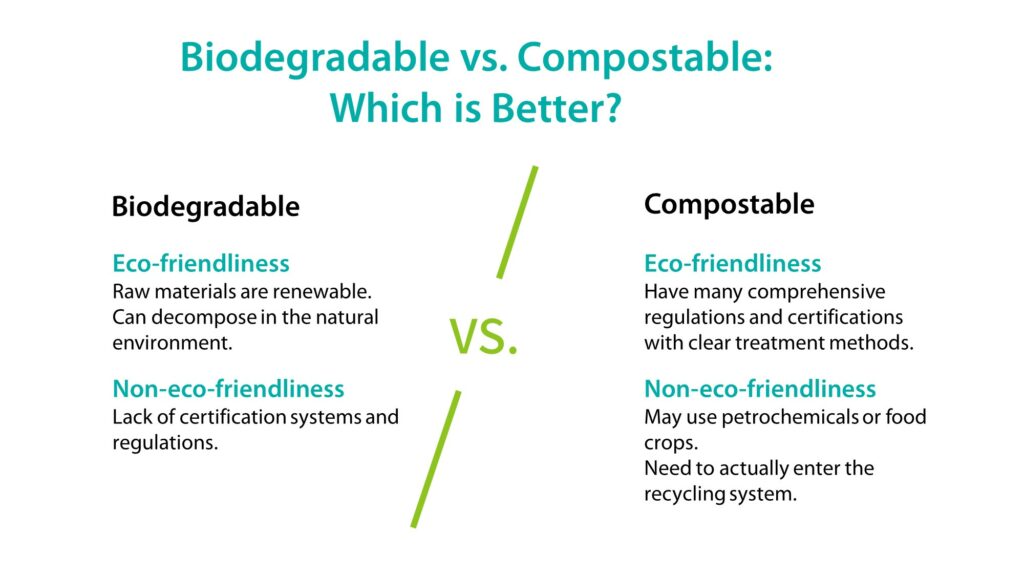
Eco-friendliness of biodegradable products
Biodegradable materials are mostly derived from nature. The raw materials are renewable and can decompose in the natural environment, which applies to situations in which products accidentally enter the environment.
Non-eco-friendliness of biodegradable products
Due to the lack of certification systems and regulations, for most products claiming to be biodegradable, it is hard to determine the speed and environmental conditions of their decomposition. It is also difficult to determine whether these biodegradable products will cause pollution after decomposition. They can easily be used as a way for unethical manufacturers to green wash their products.
Eco-friendliness of compostable products
Compostable materials have many comprehensive regulations and certifications with clear treatment methods. The biomass cycle of the earth’s resources can be effectively achieved.
Non-eco-friendliness of compostable products
Some compostable materials use petrochemicals or food crops, which can cause problems with raw material sustainability and food distribution. Also, recycling facilities in every region are different, and compostable products need to actually enter the recycling system to achieve the benefits of the biomass cycle originally designed.
Which is the more eco-friendly choice
In general, choosing compostable products is more eco-friendly as this ensures that greenwashing manufacturers are not supported. There is also a complete recycling mechanism. However, raw material sustainability and local recycling conditions should be taken into account as well. The following are some tips for selecting biodegradable and compostable products.
Tips to Choose Biodegradable Products
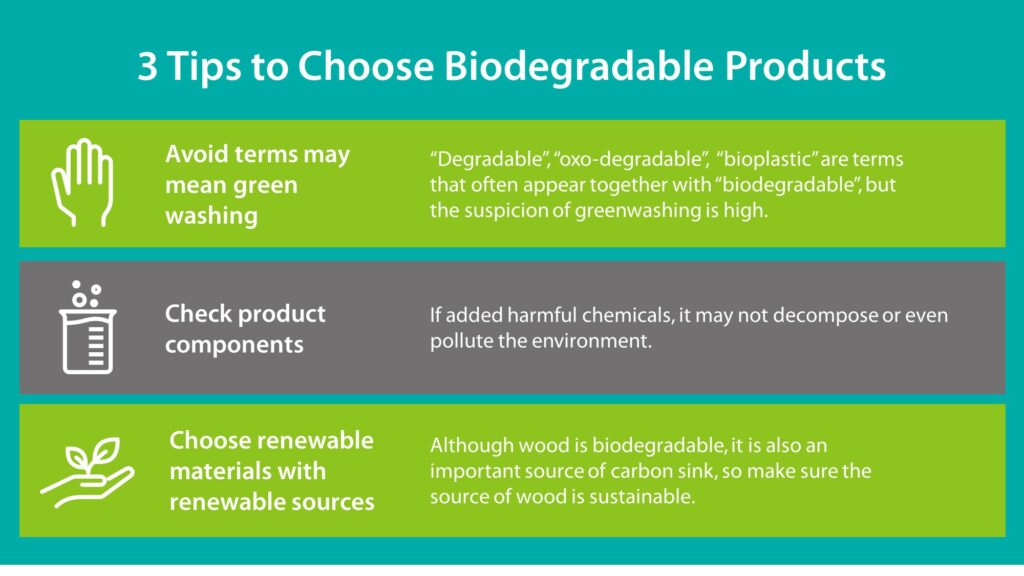
Avoid terms similar to biodegradable but may mean green washing: “degradable,” “oxo-degradable,” “bio-plastic”
When “degradable” appears alone, it usually means that the material is not biodegradable or compostable. (If it were, the manufacturer could simply claim its better decomposition performance.) There is also no clear regulation for the decomposition method or time.
Oxidative degradation is a technology banned by most countries. Additives are added to traditional plastic to decompose it. However, it doesn’t harmlessly return to the earth. Instead, it breaks down into countless microplastics, resulting in unseen pollution.
Bio-plastic is a vague term, and we cannot determine whether the product is biodegradable or made from biomass plastic. Note that although biomass plastic means renewable materials, it does not mean it is biodegradable. Therefore, we should avoid this ambiguous term.
Check product components
In the production of biodegradable products, besides natural raw materials, additional chemicals are usually added, such as ink on cardboard boxes, waterproof coatings on wood tables, and plastic decorations on cotton clothing. These substances will hinder the decomposition of biodegradable products and may even pollute the environment during the process. Therefore, it is necessary to determine whether the components of biodegradable products are harmless to the environment.
Choose renewable materials with renewable sources
Wood is the most common biodegradable material, but its source is logging. If deforestation continues, it would exacerbate climate change. The label issued by the Forest Stewardship Council® (FSC®) is one of the most credible forest certifications in the world. It addresses the entire life cycle of logging, production, and distribution. Choosing paper, furniture, and other wood products with the FSC® label can guarantee the sustainability of the wood used.

Image: Flickr
Tips to Choose Compostable Products
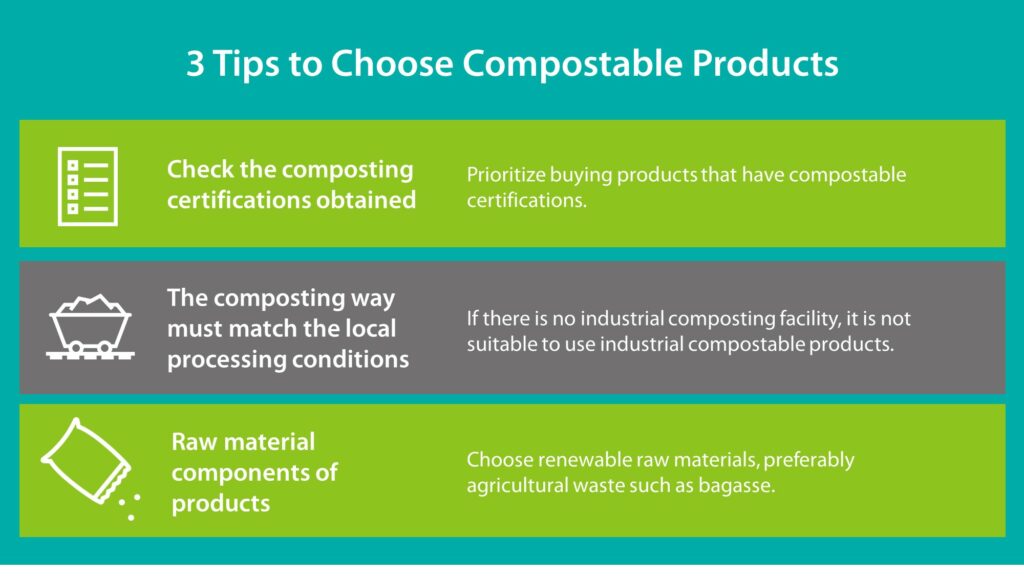
Check the compostable certifications obtained
Compostable products are best guaranteed if they have compostable certification. If the manufacturer discloses the compost certification publicly, whether it’s an industrial or home compostable certification can be directly checked. The company and test product name in the certification should be checked to see if they match the labeled product. If the compostable certification is not disclosed, it is suggested to choose products labeled with a certification from a named organization as well as whether it’s a home or industrial compostable product, or how to dispose of the product. Avoid products only labeled as “compostable” as they may be green washed.
Check whether the compostable certification matches the local processing conditions
Since the decomposition of industrial composting products is faster, if it is confirmed that there is a recycling channel in the local area that can send the products to an industrial composting facility for treatment, industrial composting products should be chosen first. If there is no industrial composting facility in the local area, it is suggested to choose home composting products with decomposition conditions similar to the ambient environment. After use, send them to a community composting site or put them in a home composting bin.
Raw material components of products
Compostable products are made of all kinds of raw materials, ranging from bio-based to petrochemical materials. To ensure the renewability of raw materials, it is suggested to choose bio-based products and try to avoid the use of food crops. Of course, if the raw material source is agricultural waste such as bagasse, which does not require additional crop planting and can reduce waste, it would be the best choice.
Biodegradeble vs. Compostable: Compostable is Also Biodegradable, Biodegradable Doesn’t Mean Compostable
“Biodegradable” is a broad and vague adjective. As long as it can be decomposed by microorganisms in the natural environment, it can be called biodegradable. Meanwhile, “compostable” requires complete testing standards that simulate established waste treatment, which can better ensure that compostable products decompose and return to the earth. Therefore, a compostable product is always a biodegradable product, but being biodegradable does not mean being compostable. Choosing compostable products and properly disposing of them is more eco-friendly than simply using biodegradable products, and it can lead to a truly sustainable future.











